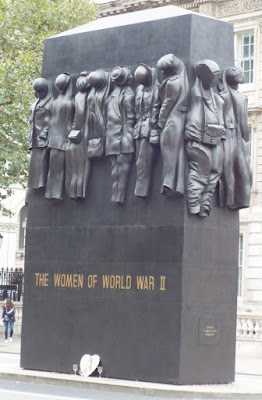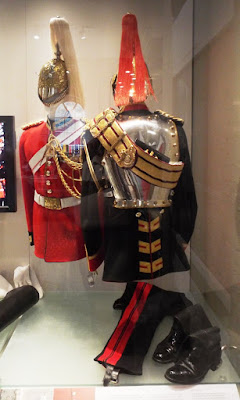Whilst Sue and I were visiting the Whitehall area of London, I had a chance to look at some of the numerous memorial and statues that have been erected there. On Horse Guards Parade itself are statues of Field Marshal Frederick Sleigh Roberts, 1st Earl Roberts, ...
... Field Marshal Garnet Joseph Wolseley, 1st Viscount Wolseley, ...
... and a memorial to Field Marshal Horatio Herbert Kitchener, 1st Earl Kitchener.
On the St James's Park side of Horse Guards Parade is the Guards Memorial, which was erected after the First World War. It commemorates the members of the Guards Division who died during the Great War as well as the dead of the Household Division from the Second World War and other conflicts that have been fought since 1918.
In Whitehall itself the most prominent memorials are the Cenotaph ...
... and the more recent Monument to the Women of World War II.
The former was erected in 1919 and the latter in 2005.
There are also three statues of British Field Marshals along one side of Whitehall. They are Field Marshal William (Bill) Joseph Slim, 1st Viscount Slim, ...
... Field Marshal Alan Francis Brooke, 1st Viscount Alanbrooke, ...
... and Field Marshal Bernard Law Montgomery, 1st Viscount Montgomery of Alamein.
... Field Marshal Garnet Joseph Wolseley, 1st Viscount Wolseley, ...
... and a memorial to Field Marshal Horatio Herbert Kitchener, 1st Earl Kitchener.
On the St James's Park side of Horse Guards Parade is the Guards Memorial, which was erected after the First World War. It commemorates the members of the Guards Division who died during the Great War as well as the dead of the Household Division from the Second World War and other conflicts that have been fought since 1918.
In Whitehall itself the most prominent memorials are the Cenotaph ...
... and the more recent Monument to the Women of World War II.
The former was erected in 1919 and the latter in 2005.
There are also three statues of British Field Marshals along one side of Whitehall. They are Field Marshal William (Bill) Joseph Slim, 1st Viscount Slim, ...
... Field Marshal Alan Francis Brooke, 1st Viscount Alanbrooke, ...
... and Field Marshal Bernard Law Montgomery, 1st Viscount Montgomery of Alamein.







































































.JPG)














